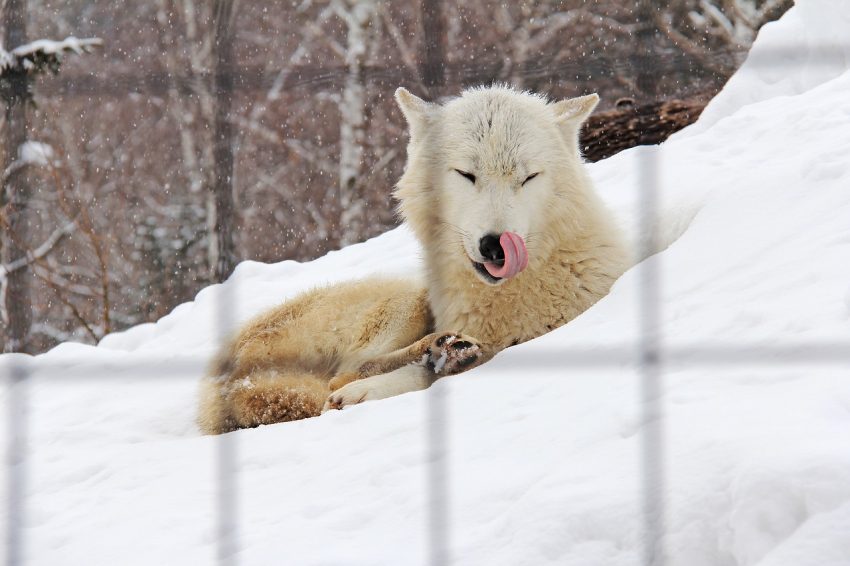In the vast expanse of the Arctic tundra, where icy winds howl and snow-covered landscapes stretch for miles, a silent and majestic figure roams—the Arctic wolf. Often described as the “lone wanderer” of the frigid north, the Arctic wolf is a captivating species with a unique way of life. In this blog post, we embark on a journey into the heart of the Arctic to unravel the mysteries surrounding the solitary existence of these remarkable creatures.
Arctic Wolves: A Subspecies of the Gray Wolf:
Arctic wolves (Canis lupus arctos) are a subspecies of the gray wolf, adapted to survive in the harsh conditions of the Arctic Circle. These wolves boast a distinctive appearance, with a thick, white fur coat that serves as both insulation against the biting cold and camouflage against the snow-covered landscapes. Their fur provides excellent insulation, allowing them to withstand temperatures that often plunge well below freezing.
Solo Prowess: The Lone Wanderer’s Lifestyle:
Unlike their gray wolf relatives, which often form packs for social structure and hunting, Arctic wolves are known for their more solitary lifestyle. The reasons behind this solitary behavior are deeply intertwined with the challenges posed by the Arctic environment.
- Scarcity of Prey: The Arctic is a vast and unforgiving landscape where prey is not as abundant as in more temperate ecosystems. This scarcity of food resources necessitates a more individualistic hunting strategy.
- Expansive Territories: Arctic wolves have vast home ranges that can span hundreds of square miles. Maintaining a solitary lifestyle allows them to cover more ground in search of prey and resources.
- Adaptation to Harsh Conditions: The Arctic is characterized by extreme weather conditions, including fierce storms and bone-chilling temperatures. A solitary existence allows Arctic wolves to adapt to these harsh conditions more efficiently.
Hunting Tactics: The Silent Pursuer:
Arctic wolves are masterful hunters, employing a variety of tactics suited to their challenging environment. While they are known to hunt alone, they may also form temporary hunting partnerships with other solitary wolves when food sources are more abundant.
- Stealth and Patience: The Arctic wolf’s white fur allows it to blend seamlessly with the snow-covered terrain, providing an excellent advantage in stalking prey. They use their keen senses of sight and hearing to patiently wait for the opportune moment to strike.
- Coordinated Ambush: In some instances, solitary Arctic wolves may join forces for a coordinated ambush, particularly when targeting larger prey. This temporary collaboration showcases the adaptability and intelligence of these solitary hunters.
- Versatile Diet: The diet of Arctic wolves is diverse and includes muskoxen, caribou, Arctic hares, and lemmings. Their ability to adapt their hunting techniques to the availability of prey highlights their resilience in the face of challenging environmental conditions.
Surviving the Elements: The Arctic Wolf’s Resilience:
Life in the Arctic demands unparalleled resilience, and Arctic wolves have evolved unique adaptations to thrive in this extreme environment.
- Thermal Insulation: The thick fur of Arctic wolves not only provides camouflage but also serves as an effective insulator against the biting cold. Even their paw pads are covered in fur to prevent direct contact with the snow.
- Specialized Coat Coloration: The white coat of the Arctic wolf is not just for show. It acts as a natural camouflage, allowing them to blend seamlessly into the snowy landscape, making them less visible to both prey and potential predators.
- Nomadic Movements: Arctic wolves are known for their nomadic lifestyle, continually moving across their expansive territories in search of prey and suitable denning sites. This constant mobility helps them navigate the challenges posed by shifting weather patterns and changing prey availability.

Reproduction and Family Dynamics:
While Arctic wolves are generally solitary, they come together during the breeding season. Mating pairs form temporarily, and a female may give birth to a litter of pups in a well-hidden den. The female is the primary caregiver, and the pups learn essential survival skills under her guidance.
The solitary nature of Arctic wolves extends to their parenting style. Unlike gray wolves that rely on pack cooperation for raising pups, Arctic wolf mothers take on the responsibility almost entirely on their own. This approach aligns with the scarcity of resources in the Arctic, as it allows for efficient use of available food.
Conservation Status and Threats:
Arctic wolves, like many other species, face threats to their survival. Climate change, habitat degradation, and the encroachment of human activities pose significant challenges.
- Climate Change Impact: The Arctic is warming at an alarming rate, affecting the wolves’ natural habitat. Changes in ice cover, altered prey distribution, and disruptions to established migration patterns all contribute to the challenges faced by Arctic wolves.
- Human Encroachment: Increased human activities, including industrial development and tourism, bring with them potential threats to Arctic wolf habitats. Habitat fragmentation and disturbance can disrupt their natural behaviors and hunting patterns.
- Conservation Efforts: Efforts are underway to monitor and protect Arctic wolf populations. Conservation initiatives focus on preserving their habitats, understanding their behaviors, and implementing measures to mitigate the impacts of climate change.
The Arctic wolf’s solitary existence is a testament to its adaptability, resilience, and mastery of survival in one of the harshest environments on Earth. As we journey into the world of the lone wanderer, we gain insight into the complex balance between individuality and cooperation that defines their lives. The Arctic wolf, with its haunting beauty and stoic resilience, continues to wander the frozen landscapes, leaving footprints in the snow and tales of survival in its wake. In protecting these iconic creatures, we also preserve a vital link to the untamed wilderness of the Arctic and the enduring spirit of the lone wanderer.

